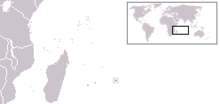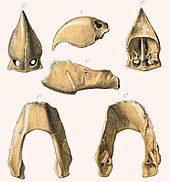Rodrigues parrot
| Rodrigues parrot | |
|---|---|

| |
Subfossil skull and limb bones, 1879
| |
| Scientific classification | |
| Domain: | Eukaryota |
| Kingdom: | Animalia |
| Phylum: | Chordata |
| Class: | Aves |
| Order: | Psittaciformes |
| Family: | Psittaculidae |
| Genus: | Necropsittacus Milne-Edwards, 1873 |
| Species: | †N. rodricanus
|
| Binomial name | |
| †Necropsittacus rodricanus (Milne-Edwards, 1867)
| |

| |
| Location of Rodrigues | |
| Synonyms | |
| |
The Rodrigues parrot or Leguat's parrot (Necropsittacus rodricanus) is an
The Rodrigues parrot was green, and had a proportionally large head and beak and a long tail. Its exact size is unknown, but it may have been around 50 cm (20 in) long. It was the largest parrot on Rodrigues, and it had the largest head of any Mascarene parrot. It may have looked similar to the great-billed parrot. By the time it was discovered, it frequented and nested on islets off southern Rodrigues, where introduced rats were absent, and fed on the seeds of the shrub Fernelia buxifolia. The species was last mentioned in 1761, and probably became extinct soon after, perhaps due to a combination of predation by introduced animals, deforestation, and hunting by humans.
Taxonomy
Birds thought to be the Rodrigues parrot were first mentioned by the French traveler

In 1867, the French zoologist
The
In another footnote to his 1873 compilation, Milne-Edwards correlated the subfossil species with parrots mentioned by Leguat.
The current whereabouts of the holotype beak are unknown. It may be specimen UMZC 575, a rostrum that was sent from Milne-Edwards to A. Newton after 1880, which matches the drawing and description in Milne-Edwards's paper, but this cannot be confirmed.[7] In 1879 the German ornithologist Albert Günther and E. Newton described more fossils of the Rodrigues parrot, including a skull and limb bones.[12] Remains of the species are scarce, but subfossils have been discovered in caves on the Plaine Corail and in Caverne Tortue.[13]
Evolution

Many
Hume has suggested that the Mascarene parrots have a common origin in the
Hypothetical extinct relatives
The British zoologist
The two assigned Necropsittacus species have since become the source of much taxonomic confusion, and their identities have been debated. N. borbonicus later received
In 1987, Cheke found the described colour-pattern of N. borbonicus remiscent of Psittacula parrots, but considered N. francicus to be based on confused reports.[4] In 2001 the British writer Errol Fuller suggested Dubois's account of N. borbonicus could either have referred to an otherwise unrecorded species or have been misleading, and found N. francicus to be "one of the most dubious of all hypothetical species".[18] In 2007, Hume suggested that Rothschild had associated N. borbonicus with the Rodrigues parrot because he had mistakenly incorporated Dubois's account into his description of the latter; he stated the Rodrigues parrot also had red plumage (though it was all-green), and had been mentioned by Dubois (who never visited Rodrigues). Rothschild also attributed the sighting of N. francicus to Dubois, repeating the colour-pattern he had described earlier for the Rodrigues parrot, and this led Hume to conclude that the name N. francicus was based solely on "the muddled imagination of Lord Rothschild". Hume added that if Dubois's description of N. borbonicus was based on a parrot endemic to Réunion, it may have been derived from the Alexandrine parakeet, which has a similar colouration, apart from the red tail.[7][16]
Description
The Rodrigues parrot was described as being the largest parrot species on the island, with a big head and a long tail. Its plumage was described as being of uniform green colouration.
The Rodrigues parrot was similar in skeletal structure to the parrot genera
Behaviour and ecology

Tafforet's 1726 description is the only detailed account of the Rodrigues parrot in life:
The largest are larger than a pigeon, and have a tail very long, the head large as well as the beak. They mostly come on the islets which are to the south of the island, where they eat a small black seed, which produces a small shrub whose leaves have the smell of the orange tree, and come to the mainland to drink water ... they have their plumage green.[7]
Tafforet also mentioned that the parrots ate the seeds of the shrub Fernelia buxifolia ("bois de buis"), which is endangered today, but was common all over Rodrigues and nearby islets during his visit. Leguat mentioned that the parrots of the island ate the nuts of the tree Cassine orientalis ("bois d'olive"). Due to a large population of introduced rats on Rodrigues, the parrots, the Rodrigues starling, and the Rodrigues pigeon, frequented and nested on offshore islets, where the rats were absent.[7]
Many of the other endemic species of Rodrigues became extinct after the arrival of humans, so the ecosystem of the island is heavily damaged. Before humans arrived, forests covered the island entirely, but very little remains today due to deforestation. The Rodrigues parrot lived alongside other recently extinct birds such as the Rodrigues solitaire, the Rodrigues rail, Newton's parakeet, the Rodrigues starling, the Rodrigues scops owl, the Rodrigues night heron, and the Rodrigues pigeon. Extinct reptiles include the domed Rodrigues giant tortoise, the saddle-backed Rodrigues giant tortoise, and the Rodrigues day gecko.[2]
Extinction
Of the eight or so parrot species endemic to the Mascarenes, only the echo parakeet of Mauritius has survived. The others were likely all made extinct by a combination of excessive hunting and deforestation by humans. Like mainland Rodrigues, the offshore islets were eventually infested by rats, which is believed to have caused the demise of the Rodrigues parrot and other birds there.[7] Cats may also have hunted the remaining birds.[21] The rats probably preyed on their eggs and chicks.[19]
Leguat mentioned use of local parrots as food, but it is uncertain whether the green species was the Rodrigues parrot or a green Newton's parakeet:[7]
There are abundance of green and blew Parrets, they are of a midling and equal bigness; when they are young, their Flesh is as good as young Pigeons.[7]
Pingré indicated in 1671 that local species were popular game, and found that the Rodrigues parrot was rare:
The perruche [Newton's parakeet] seemed to me much more delicate [than the flying-fox]. I would not have missed any game from France if this one had been commoner in Rodrigues; but it begins to become rare. There are even fewer perroquets [Rodrigues parrots], although there were once a big enough quantity according to François Leguat; indeed a little islet south of Rodrigues still retains the name Isle of Parrots [Isle Pierrot].[7]
Pingré also reported that the island was becoming deforested by tortoise hunters who set fires to clear vegetation. Along with direct hunting of the parrots, this likely led to a reduction in the population of Rodrigues parrots. Pingré's 1761 account is the last known mention of the species, and it probably became extinct soon after.[7]
References
- . Retrieved 19 November 2021.
- ^ ISBN 978-0-7136-6544-4.
- ^ a b Leguat, F. (1891). Pasfield Oliver, S. (ed.). The voyage of François Leguat of Bresse, to Rodriguez, Mauritius, Java, and the Cape of Good Hope. Vol. 1. London: Hakluyt Society. pp. 84–85. Archived from the original on 2016-04-11. Retrieved 2017-02-23.
- ^ ISBN 978-0-521-11331-1.
- S2CID 128901896.
- ^ Milne-Edwards, A. (1867). "Une Psittacien fossile de l'Île Rodrigue". Annales des Sciences Naturelles, Zoologie. Series 5 (in French). 8: 145–156. Archived from the original on 2017-10-25. Retrieved 2018-01-13.
- ^ (PDF) from the original on 2016-03-21. Retrieved 2013-08-05.
- ^ a b Milne-Edwards, A. (1866–1873). Recherches sur la faune ornithologique éteinte des iles Mascareignes et de Madagascar (in French). Paris: G. Masson. pp. 23–34. Archived from the original on 2016-10-10. Retrieved 2017-02-11.
- ^ Gill, F.; Donsker, D. (2014). "Parrots & cockatoos". IOC World Bird List. Archived from the original on May 17, 2016. Retrieved February 11, 2017.
- ^ Milne-Edwards, A. (1873). "Recherches sur la faune ancienne des Iles Mascareignes". Annales des Sciences Naturelles, Zoologie. Series 5 (in French). 19: 1–31. Archived from the original on 2017-02-27. Retrieved 2018-02-21.
- ^ Newton, A. (1875). "Additional evidence as to the original fauna of Rodriguez". Proceedings of the Zoological Society of London: 39–43. Archived from the original on 2017-10-02. Retrieved 2018-01-13.
- ^ .
- ^ Hume, J. P. (2013). Göhlich, U. B.; Kroh, A. (eds.). "A synopsis of the pre-human avifauna of the Mascarene Islands" (PDF). Proceedings of the 8th International Meeting of Society of Avian Paleontology and Evolution: 195–237. Archived (PDF) from the original on 2016-03-03. Retrieved 2017-02-11.
- from the original on 2017-09-11. Retrieved 2018-01-13.
- ISBN 978-0-511-73576-9.)
{{cite book}}: CS1 maint: location missing publisher (link - ^ a b Rothschild, W. (1905). "On extinct and vanishing birds". Ornis (Proceedings of the 4th International Ornithological Congress, London). 14: 191–217. Archived from the original on 2017-11-07. Retrieved 2018-01-13.
- ^ Rothschild, W. (1907). Extinct Birds. London: Hutchinson & Co. pp. 61–62. Archived from the original on 2018-05-09. Retrieved 2014-07-25.
- ^ ISBN 978-0-8014-3954-4.
- ^ ISBN 978-1-4081-5725-1.
- ISBN 978-0-486-21869-4.
- ^ Cheke, A. S. (2013). "Extinct birds of the Mascarenes and Seychelles – a review of the causes of extinction in the light of an important new publication on extinct birds". Phelsuma. 21: 4–19.
External links
 Media related to Necropsittacus rodricanus at Wikimedia Commons
Media related to Necropsittacus rodricanus at Wikimedia Commons Data related to Psittaculini at Wikispecies
Data related to Psittaculini at Wikispecies



